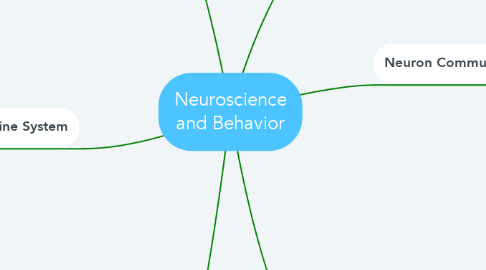
1. Neurotransmitters
1.1. ACETYLCHOLINE: Neurotransmitters that cause muscle contractions
1.2. DOPAMINE: Neurotransmitter involved in the regulation of bodily movement, thought processes, and rewarding sensations
1.3. SEROTONIN: Neurotransmitter involved in sensory perceptions, sleep, and emotions
1.4. NOREPINEPHRINE: Neurotransmitter involved in learning, memory, and regulation of sleep; also a hormone manufactured by adrenal glands
1.5. GLUTAMATE: Neurotransmitter that usually communicates an excitatory glands
1.6. GABA(gamma-aminobutyric acid): Neurotransmitter that usually communicates an inhibitory message
1.7. ENDORPHINS: Neurotransmitter that regulate pain perceptions
2. Endocrine System
2.1. Communicate through hormones released into the bloodstream
2.2. Glands
2.2.1. Pineal gland
2.2.2. Pancreas
2.2.3. Thyroid
2.2.4. ADRENAL GLANDS: The pair of endocrine glands that are involved in the human stress response
2.2.5. PITUITARY GLAND: The endocrine gland attached to the base of the brain that secretes hormones affecting the function of other glands as well as hormones that act directly on physical processes
2.2.6. GONADS: Ovaries in women | Testes in men
2.3. The hypothalamus produces oxytocin and is released into the bloodstream by the pituitary gland
3. The Brain
3.1. Imaging the Brain
3.1.1. PET(Positron-emsson tomography)
3.1.1.1. Increased activity in a particular brain region shown with increased blood flow and energy consumption
3.1.1.2. Radioactive substance injected into the bloodstream
3.1.1.3. Produces a color coded image of the brains activity
3.1.2. MRI(Magnetic resonance imaging)
3.1.2.1. Lie in a magnetic tube while brain receives magnetic fields
3.1.2.2. Analyzes electromagnetic signals generated by brain tissue molecules
3.1.2.3. Produces digital images
3.1.3. fMRI(Functional MRI)
3.1.3.1. Lies in magnetic tube while computer tracks electromagnetic signals generated by the brains metabolic activity
3.1.3.2. Measures the ebb ad flow of oxygenated blood in the brain
3.1.3.3. Produces a series of of scans that show movement by movement of the brains changing activity
3.2. Plasticity
3.2.1. Structural Plasticity: Capacity to change physical structure in response to learning, active practice, or environmental influences
3.2.2. Functional Plasticity: Capacity to shift functions from damaged to undamaged brain areas
4. Parts of a Neuron
4.1. Cell body: Contains nucleus and provides energy
4.2. Dendrites: Receive info from other neurons
4.3. Axon: Sends info to other neurons
5. Neuron Communication
5.1. Synaptic Transmission
5.1.1. 1. ACTION POTENTIAL travels along AXON of sending neuron
5.1.1.1. AXON: The long fluid filled tube that carries a neurons messages to other body errors
5.1.1.2. ACTION POTENTIAL: A brief electrical impulse by which info is transmitted along the axon of a neuron
5.1.2. 2. ACTION POTENTIAL triggers release of NEUROTRANSMITTERS by SYNAPTIC VESICLES
5.1.2.1. NEUROTRANSMITTERS: Chemical messengers manufactured by a neuron
5.1.2.2. SYNAPTIC VESICLES: The tiny pouches or sacs in axon terminals that contain chemicals called neurotransmitters
5.1.3. 3. NEUROTRANSMITTERS cross SYNAPTIC GAP and bind to the correctly shaped receptor sites on postsynaptic neuron
5.1.3.1. SYNAPTIC GAP: The tiny space between the axon terminal of one neuron and the dendrite of an adjoining neuron
6. Cerebral Cortex
6.1. Limbic System:
6.1.1. Hippocampus: Memory
6.1.2. Thalamus: Sensory info, awareness and attention
6.1.3. Hypothalamus: Links the brain and endocrine system; hunger, thirst, sleep, sexual behavior
6.1.4. Amygdala: Emotional responses and memory
6.2. Lobes
6.2.1. Temporal Lobe: Primary auditory; hearing and processing auditory info
6.2.2. Frontal Lobe: Motor cortex; controls voluntary movement
6.2.3. Occipital Lobe: Visual cortex; processes visual info
6.2.4. Parietal Lobe: Somatosensory cortex; processes touch and other body info
6.3. Two cerebral hemispheres connected by corpus callous
6.3.1. Roger Sperry(1913-1994) Split brain research
6.3.1.1. Left hemisphere: Language, grammar, writing, reading, math verbal memory
6.3.1.2. Right hemisphere: Visual-spatial, patterns, faces, emotional expressions, music
